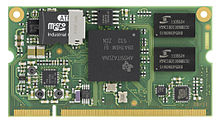Embedded system
![]()
This article or subsequent section is not sufficiently supported by evidence (e.g., anecdotal evidence). Information without sufficient evidence may be removed in the near future. Please help Wikipedia by researching the information and adding good supporting evidence.
An embedded system is an electronic computer that is embedded in a technical context. The computer either performs monitoring, control or regulating functions or is responsible for some form of data or signal processing, for example encryption or decryption, coding or decoding or filtering.
Embedded systems perform - largely invisible to the user - the service in a variety of application areas and devices, for example in medical technology devices, washing machines, aircraft, motor vehicles, refrigerators, televisions, DVD players, set-top boxes, routers, mobile phones or generally in consumer electronics devices. In the case of complex overall systems, this usually involves networking a large number of otherwise autonomous, embedded systems (such as in vehicles or aircraft).
Often, embedded systems are specifically adapted to a task. For cost reasons, an optimized, mixed hardware-software implementation is chosen. Such a design combines the great flexibility of software with the performance of hardware. The software is used both to control the system itself and to interact the system with the outside world via defined interfaces or protocols (e.g. LIN bus, CAN bus, ZigBee for wireless communication or IP via Ethernet).

Embedded system on a plug-in card with processor, memory, power supply, and external interfaces
Characterization
Embedded systems can in individual cases be based on similar hardware to workstation computers (embedded PCs). Typically, however, they are subject to strongly restrictive boundary conditions: minimum costs, low space, energy and memory consumption. Individual components such as processor and main memory are often based on further developments of older components, which facilitates long-term usability and spare parts procurement. "Modern" embedded systems are often based on processor platforms that have little in common with the PC world, but are highly integrated in terms of peripheral modules and consume significantly less energy thanks to modern power-saving techniques.
For many applications, the use of an older processor architecture can help to reduce costs. For example, the architectures of the MCS-51, Microchip 8-bit PIC or Z80 series are still a very popular basis for embedded systems despite their age and known weaknesses. The reuse of program code and toolchains as well as the shyness of complete redesigns "without necessity" are also marginal factors that should not be underestimated here, in addition to the pure material costs.
In an embedded system, the software often has to meet real-time requirements. As a rule, compared to PC hardware, only greatly reduced resources exist, mostly without a hard disk, often without an operating system, keyboard or screen. A ROM or flash chip replaces mechanical memory components such as a hard disk; power-saving processors manage without fans, because moving parts mean wear and tear and susceptibility to errors. If at all, there is usually only a keypad, and the output is realized - as far as provided - by an LCD.
The software on such a device is called firmware. It is usually located on a ROM, but more and more often on flash memory. In the case of flash memory, it is possible to update the firmware without having to replace the chip. If only a ROM is present, the entire chip usually has to be replaced, sometimes the entire circuit.
Firmware Components
Essentially, the firmware consists of three components.
Bootloader
Provides for the loading of the operating system and the application software. It also offers the option of updating the operating system and application software in the flash memory. This can be done either via a serial interface (RS232) or via Ethernet and IP. Known boot loaders for embedded systems are RedBoot or U-Boot.
Operating system
This software part takes care of multitasking, memory and file management (e.g. JFFS2) as well as IP services like TFTP, HTTP, SNMP and Telnet.
Application software
This part contains the application-specific software. This is also referred to as application software.
For small embedded systems, the three software parts may be combined.
Questions and Answers
Q: What is an embedded system?
A: An embedded system is a computer built to solve specific problems and is not easy to change.
Q: How does an embedded system differ from a general-purpose computer?
A: An embedded system usually does not have a keyboard, monitor, or mouse and has specialized functions. A general-purpose computer can perform a wide range of tasks.
Q: What are some examples of embedded systems?
A: Examples of embedded systems include elevator controllers, set-top boxes, card readers in hotel door locks, traffic light systems, airplanes, and assembly lines in factories.
Q: What is real-time computing?
A: Real-time computing is when an embedded system must complete its work within a specific amount of time. If it is interrupted, it can cause problems like poor picture quality on a TV.
Q: What are the components of an embedded system?
A: Like any computer, an embedded system has a processor, software, input, and output.
Q: What are some tasks an embedded system might control?
A: An embedded system might control small devices like MP3 players or digital cameras, or larger systems like traffic lights or airplanes.
Q: What does the term "embedded" mean in relation to embedded systems?
A: The term "embedded" means that the computer is built into a larger system and is not easily changed.
Search within the encyclopedia